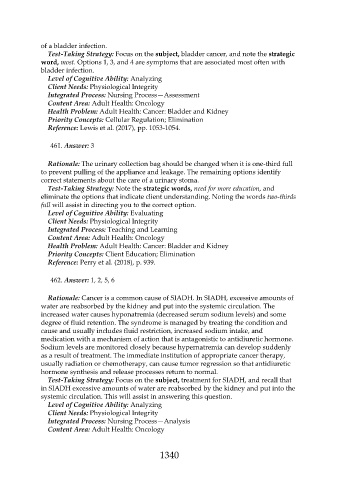Page 1340 - Saunders Comprehensive Review For NCLEX-RN
P. 1340
of a bladder infection.
Test-Taking Strategy: Focus on the subject, bladder cancer, and note the strategic
word, most. Options 1, 3, and 4 are symptoms that are associated most often with
bladder infection.
Level of Cognitive Ability: Analyzing
Client Needs: Physiological Integrity
Integrated Process: Nursing Process—Assessment
Content Area: Adult Health: Oncology
Health Problem: Adult Health: Cancer: Bladder and Kidney
Priority Concepts: Cellular Regulation; Elimination
Reference: Lewis et al. (2017), pp. 1053-1054.
461. Answer: 3
Rationale: The urinary collection bag should be changed when it is one-third full
to prevent pulling of the appliance and leakage. The remaining options identify
correct statements about the care of a urinary stoma.
Test-Taking Strategy: Note the strategic words, need for more education, and
eliminate the options that indicate client understanding. Noting the words two-thirds
full will assist in directing you to the correct option.
Level of Cognitive Ability: Evaluating
Client Needs: Physiological Integrity
Integrated Process: Teaching and Learning
Content Area: Adult Health: Oncology
Health Problem: Adult Health: Cancer: Bladder and Kidney
Priority Concepts: Client Education; Elimination
Reference: Perry et al. (2018), p. 939.
462. Answer: 1, 2, 5, 6
Rationale: Cancer is a common cause of SIADH. In SIADH, excessive amounts of
water are reabsorbed by the kidney and put into the systemic circulation. The
increased water causes hyponatremia (decreased serum sodium levels) and some
degree of fluid retention. The syndrome is managed by treating the condition and
cause and usually includes fluid restriction, increased sodium intake, and
medication with a mechanism of action that is antagonistic to antidiuretic hormone.
Sodium levels are monitored closely because hypernatremia can develop suddenly
as a result of treatment. The immediate institution of appropriate cancer therapy,
usually radiation or chemotherapy, can cause tumor regression so that antidiuretic
hormone synthesis and release processes return to normal.
Test-Taking Strategy: Focus on the subject, treatment for SIADH, and recall that
in SIADH excessive amounts of water are reabsorbed by the kidney and put into the
systemic circulation. This will assist in answering this question.
Level of Cognitive Ability: Analyzing
Client Needs: Physiological Integrity
Integrated Process: Nursing Process—Analysis
Content Area: Adult Health: Oncology
1340

